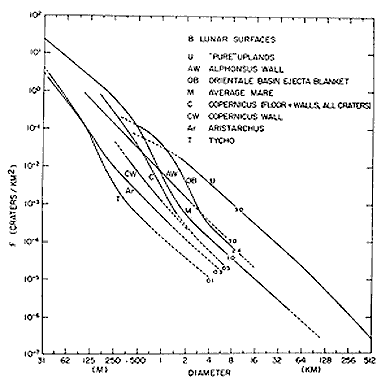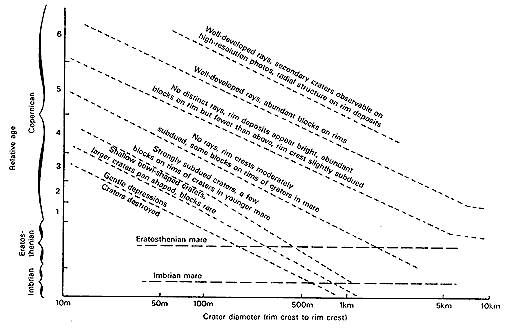Extraordinary as these orbital photos were at the time, much more had to be learned about the actual surface from a close-up vantage. Landing a viewing and sampling system on the surface was a high priority in pre-Apollo days. The Soviet Union was first to achieve this with their Luna 9 in early 1966, as documented in this view of the rock-strewn surface of the mare lavas in Oceanus Procellarum.
The U.S. quickly followed in May of 1966 when Surveyor 1 touched down in the western Oceanus Procellarum. Shown here as it was tested on Earth prior to launch, the instrument module rests on four pod-footed legs. Surveyor's TV camera provides pans of the immediate site and nearby features.

Surveyor 1 obtained close-up views of some individual larger rocks, such as seen below. This rock shows mottled dark and light patches that, based on Apollo sample returns, suggest it to be a lunar breccia containing both highlands and mare rock fragments.
Four more Surveyors (out of a total of 7) successfully landed; none sank as feared into weak surface materials. Surveyors 3 and 7 had an extendable pantograph arm that served as a soil mechanics surface sampler. Surveyors 5, 6, and 7 had magnets to collect metallic particles. The image mosaic below shows a panoramic view at the 7 site:
They also carried alpha-particle backscatter instruments to sense outputs from certain elements (Fe, Ti, Na, Al, Mg); the first solid evidence of feldspar as a primary constituent of the highlands came from Surveyor 7's analysis of its immediate vicinity. Here is a typical Surveyor 7 view of the area near Tycho:
Early in the space program, when a lunar landing was the prime goal, information on the detailed morphology and other conditions on the surface was urgently needed. A series of missions were planned and executed that would lead to high quality geologic maps of the entire front side of the Moon. Geologists at the U.S. Geological Survey in Flagstaff, AZ and elsewhere had already begun this mapping in the days before Lunar Orbiter by direct telescopic observations - a noble effort that involved peering for hours through an eyepiece in a cold observatory, accompanied by sketching each item seen in the advancing fields of view.
These maps were the first with any detail for any of the other members of the solar system. The principles used to construct them were derivatives of the procedures applied to aerial photos (except that at the time field checks [actual ground truthing] were not an option to validate map accuracy). Units were first defined on the basis of albedos or relative reflectances, essentially by their tonal variations as observed visually or in photos taken through the telescope. Two fundamental concepts in stratigraphy were the chief guides: 1) the law of crosscutting - features or structures cut into the terrain were younger than the materials making up that terrain; and 2) the law of superposition - materials on top of the terrain are emplaced (by deposition or extrusion) later than those beneath, with each overlying layer being progressively younger than the layer(s) immediately below. (The most common exceptions - where structural deformation places older units on top of younger at thrust faults or where a fold lies on its side - do not seem to occur on the Moon which lacks the conditions for compression needed to produce these effects.)
However, a new concept, using crater frequency and morphology, was developed specifically for the Moon as a major tool in determining relative ages; sparsity of craters on Earth preclude its use on our planet but crater "dating" works well on the many planetary bodies since imaged by missions beyond the Moon. The notion underlying crater frequency (or density, i.e., numbers of craters of all discernible sizes within some arbitrary counting area [typically 106 km2]) is straightforward. The simple idea is this: as time goes on more and more craters will be formed within the area, until all the space is occupied by them, i.e., the surface is said to be saturated. Thus, older surfaces will have more craters (higher frequency of craters of all sizes). The number of increasingly larger craters diminishes with size; there are ever greater numbers of progressively smaller craters. This relationship is evident in this plot of crater frequencies for 8 areas of the Moon whose relative ages are expressed by the position of each plot.

The "pure" uplands surface (curve U) is probably the oldest, whereas those associated with Aristarchus (A) and Tycho (T) are youngest. This means that for any given crater size (say, 250 m [820 ft] diameter), there will be more craters per unit area (extrapolating to the ordinate or left vertical axis) in the uplands (~ 10-1) than in the maria (M) and, in turn, more mare craters than in Tycho (~10-3). Most of the plots are nearly parallel to one another, indicating the same relative proportions of craters at all size ranges. The relative ages generalized here were confirmed by radiometric age dating of Apollo lunar samples collected from terrains whose ages had been estimated earlier by this crater frequency counting method.
The next plot is a refinement of this technique that relies on modifications of crater shapes and degrees of degradation. A fresh crater should be characterized by a

sharply defined rim, well-preserved interior terraces, a distinct external ejecta blanket, and, if large, persistence of secondary rays. The degree of degradation depends both on the length of time since its formation and on its size. Consider the category strongly subdued. If such a crater were 50 m (164 ft) in diameter, it would belong to the Copernican class (see stratigraphic classification below) falling at about 3.8 (in relative age units; not in billions of years) on the age axis, but if it were 500 m (1640 ft) wide it would place in the Erastothenian age group.
The classic example of lunar geologic mapping is the region around the great crater Copernicus. Look at this earth-based telephoto of Copernicus and its surroundings:
The most obvious feature is the crater with its slumped walls, central peak, and the ejecta blanket and rays that extend beyond. This crater is considered the "type locality" for impact structures on the Moon. The interior and rim of Copernicus was photographed by the Apollo 11 astronauts as a major target of interest.
Now, examine the color-coded map made by astrogeologists from the U.S. Geological Survey, largely by long hours of observations through telescopes:
The oldest units are in blues and purples, being highlands-like terrain consisting of ejecta blocks tossed over the lunar landscape from the impact of an asteroid that formed the Imbrium Basin to the north. These units, known as the Fra Mauro formation, are largely "submerged" by the mare lavas (lavendar-pink) filling the edge of Oceanus Procellarum. Small maroon patches are lava domes. These lava plains were cut by craters, including Erastothenes (large one NE of Copernicus, with its well-defined hummocky ejecta blanket), rendered in green.but one crater, Stadius, to the right of Copernicus, is older, being largely covered by lavas so only a faint outline remains. Copernicus itself is surrounded by ejecta (yellow) and a younger central fill (orange). Small red units are dark-halo craters of probable volcanic origin. Many of these relationships are difficult to see in the photograph but are visible to the geologists peering through their telescopes.
General mapping of the lunar surface in this way, re-enforced by radiometric age dating of returned Moon rocks, has led to a system of lunar units classification that follows the conventional stratigraphic approach used on Earth. Thus, intervals of time have been assigned Period names and all events within these spans are relatively ranked and, for distinct units, given Formation names. This is summarized in the stratigraphic column depicted in Earthlike Planets (by Murray, Malin, and Greeley, 1981). In this version, Period names are replaced by their equivalents in System (time-stratigraphic) terms. (Note: the Copernican System/Period began about 1.1 billion years ago.)
Code 935, Goddard Space Flight Center, NASA
Written by: Nicholas M. Short, Sr. email: nmshort@epix.net
and
Jon Robinson email: Jon.W.Robinson.1@gsfc.nasa.gov
Webmaster: Bill Dickinson Jr. email: rstwebmaster@gsti.com
Web Production: Christiane Robinson, Terri Ho and Nannette Fekete
Updated: 1999.03.15.